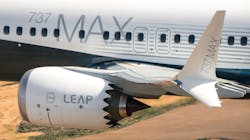Taking the LEAP: CFM’s Successor to the Fabulous 56
CFM’s new LEAP powerplant is no mere tweak of the ubiquitous CFM56. Nor is it a bridge too far. It is very much an evolutionary engine, but one with a revolutionary tang to it.
“Basically there are just a few building blocks of a gas turbine engine,” says Bill Dwyer, services marketing manager for GE Aviation (CFM International was formed as a joint company between GE and Safran Aircraft Engines). The essential elements of a jet engine are materials, aerodynamics, architecture, and experience.
Dwyer says LEAP represents a step forward in each of those areas: composite fan blades, composite case, and ceramic matrix composites in the high-pressure turbine shroud — as well as a high-pressure hot section compressor that produces an impressive 22:1 compression ratio (a reduction in the volume of air 22 times as it passes through the compressor). This critical ratio is twice that of the CFM56 family’s.
Paring Down Particulates
There’s a downside to advanced blade aerodynamics. The power-producing airfoils are more susceptible to wear. This susceptibility is felt most keenly in places such as China, India, and the Middle East, where Dwyer says, “there’s a high concentration of airborne particulates.” CFM’s answer to the problem was to fit LEAP with a debris rejection system. The aim is to keep sand, salt, gravel airborne effluent, and the like from migrating to the engine’s core where they can wreak havoc with parts and erode fuel economy.
Here’s how the debris rejection system works. During takeoff, an inherently high-thrust affair — especially at hot and high airports — variable bleed valves are opened. The idea is to direct debris around the engine, rather than through it. During lower-thrust flight regimen the doors are closed. This begets better fuel economy. The result, says CFM, “is an infinitely more durable engine.”
Time-on-wing and fuel economy are two of LEAP’s largest selling points. CFM says current production CFM56s have a 20,000-cycle life-limit on the core, and a 25,000-cycle limit on the low-pressure system. The CFM56 and LEAP share the same core life cycle limit, but the newer powerplant possesses a 30,000-cycle life-limit on the low-pressure system.
In written response to Aircraft Maintenance Technology, CFM says, “The commitment to customers was that LEAP maintenance costs would be comparable to that of the CFM56 … At the end of the day, we expect total engine life-cycle costs to be comparable to what customers have experienced with the CFM56 family” — this despite the introduction of some cutting-edge materials and blade aerodynamics.
Longevity and durability are hard-won when it comes to gas turbine engines. “Historically, [they] always used rich quench lean combustion,” says Dwyer. “It’s easier to do. It’s lighter weight.” It’s also the source of hot streaks. He says the durability-robbing spots are concentrated on the static parts of the turbine. “That’s’ where parts wear out.” It’s also where LEAP’s new TAPS II twin-annular, premixing swirler comes into play. Think of it as a nozzle on a dual mission: to lower maintenance costs and cut greenhouse gas emissions at the same time.
Fuel and air are premixed before they enter the combustion chamber for ignition. CFM says TAPS II produces “a more benign temperature profile.” “Lean burn combustion lowers the difference between the average and the peak [temperatures],” says Dwyer. “It’s a huge part of our design formula.”
If TAPS II is revolutionary, so is the way the nozzle is fabricated. It’s formed by additive manufacturing. CFM contends the fast-growing technique enables the engine-maker to produce parts “not possible with conventional equipment. The use of the technique enables engineers to design the part the way it needs (author’s emphasis) to be, rather than to accommodate traditional subtractive manufacturing [methods].”
LEAP’s vaunted 15 percent fuel burn savings emanates from two areas of the engine: Half comes from the high-pressure compressor, the other half from the fan.
Fantastic Fan
Based on what the company calls “fourth-generation aerodynamic design,” LEAP features single-piece composite fan blades and fan case.
CFM parent company Safran has been working on a way to fashion new fan blade resin for more than a quarter of a century. CFM doesn’t detail just how the blades are manufactured. It does say the proprietary process entails weaving the carbon fiber on a three-dimensional loom, injecting resin and then baking the assembly in an autoclave. The final touch is application of a titanium leading edge.
There’s an old axiom in engineering that the fewer pieces a structure possesses the easier it is to maintain. LEAP’s composite fan has a mere 18 wide-chord blades. That’s half the number of the CFM56-5B and 25 percent fewer than the CFM56-7B.
What airlines and aircraft leasing companies alike revel in the most, however, is this: LEAP burns 15 percent less fuel than its predecessor powerplant. Half of the 15 percent efficiency gain comes from propulsive efficiency – better aerodynamics. The fan is part ‘n parcel of that. But there are also aerodynamic improvements in the core.
The other half comes from thermal efficiency – operating at higher temperatures and pressure ratios. Although the LEAP engine does burn hotter than the CFM56, it is still below the GE90 and GEnx. The twist is that CFM has maintained the durability of the CFM56 family. The blades in the LEAP high-pressure turbine are made of the same material as those of the CFM56, but CFM has incorporated improved cooling technology and aerodynamics to maintain durability. Look at the temperature profile of a LEAP blade and a CFM56 blade. You can’t tell the difference, which means it is more durable. That is another reason why the OEM contends maintenance costs will be on par with the current engine family.
It’s not as if massive, high-bypass ratio, other-than-metal fans are a new invention. Through its parent companies, GE and Safran, CFM has a world, quite literally, of experience with big, lighter-weight fan blades fabricated from carbon fiber composites.
Consider, the GE90 has been flying since the middle of the last decade of the century, 1995 to be precise. The engine has tallied in excess of 60 million flight hours. As of this writing, there have been zero ADs (Airworthiness Directives) covering the GE90’s composite fan blades, and a mere handful have been removed from service. The engine-maker asserts, “This is the kind of record we expect the LEAP engine to achieve.”
MRO and LEAP
As of this writing, CFM says it’s booked orders for some 12,000 LEAP powerplants. The LEAP-1A was introduced into commercial service on the Airbus A320neo in August 2016. LEAP-1B is slated to see service powering Boeing’s 737 MAXes this year. LEAP-1C should fly beneath the fledgling wings of the new COMAC C919 in 2019 or thereabouts.
Although just a handful of airlines are actually operating Airbus neos so far, dispatch rates and other operational indices are impressive. Nine months into line flying, CFM said LEAP was flying 98 percent of available days. Some carriers are logging 11 flights per day and wringing out 25-minute gate turns.
When the first LEAP comes off wing for overhaul, indications are there will be enough options to accommodate the demand. Currently a trio of shops is certified to pull LEAP overhauls: Lafayette, IN; Brussels, Belgium; and San Quentin, France. All three are internal GE or Safran facilities. Third-party MRO shops have yet to be announced. “We are years away from the first LEAP overhaul,” says CFM. These third-party announcements “will be made at some point in the future.”
Meanwhile, new LEAPs continue to flow from a key domestic facility: GE’s Lafayette, IN, plant. Some 500 hot section modules — consisting of compressor, combustor, and high-pressure turbine — are being manufactured at GE’s U.S. facility.



